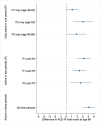Timing of physical activity across adulthood on later-life cognition: 30 years follow-up in the 1946 British birth cohort
- PMID: 36810321
- PMCID: PMC10176405
- DOI: 10.1136/jnnp-2022-329955
Timing of physical activity across adulthood on later-life cognition: 30 years follow-up in the 1946 British birth cohort
Abstract
Background: To assess how timing, frequency and maintenance of being physically active, spanning over 30 years in adulthood, is associated with later-life cognitive function.
Methods: Participants (n=1417, 53% female) were from the prospective longitudinal cohort study, 1946 British birth cohort. Participation in leisure time physical activity was reported five times between ages 36 and 69, categorised into: not active (no participation in physical activity/month); moderately active (participated 1-4 times/month); most active (participated 5 or more times/month). Cognition at age 69 was assessed by tests of cognitive state (Addenbrooke's Cognitive Examination-III), verbal memory (word learning test) and processing speed (visual search speed).
Results: Being physically active, at all assessments in adulthood, was associated with higher cognition at age 69. For cognitive state and verbal memory, the effect sizes were similar across all adult ages, and between those who were moderately and most physically active. The strongest association was between sustained cumulative physical activity and later-life cognitive state, in a dose-response manner. Adjusting for childhood cognition, childhood socioeconomic position and education largely attenuated these associations but results mainly remained significant at the 5% level.
Conclusions: Being physically active at any time in adulthood, and to any extent, is linked with higher later-life cognitive state, but lifelong maintenance of physical activity was most optimal. These relationships were partly explained by childhood cognition and education, but independent of cardiovascular and mental health and APOE-E4, suggestive of the importance of education on the lifelong impacts of physical activity.
Keywords: alzheimer's disease; cognition; dementia; neuroepidemiology.
© Author(s) (or their employer(s)) 2023. Re-use permitted under CC BY. Published by BMJ.
Conflict of interest statement
Competing interests: None declared.
Figures




References
-
- Martin Prince A, Wimo A, Guerchet M. World Alzheimer report 2015 the global impact of dementia an analysis of prevAlence, incidence cost and trends, 2015.
Publication types
MeSH terms
Grants and funding
LinkOut - more resources
Full Text Sources
Miscellaneous
